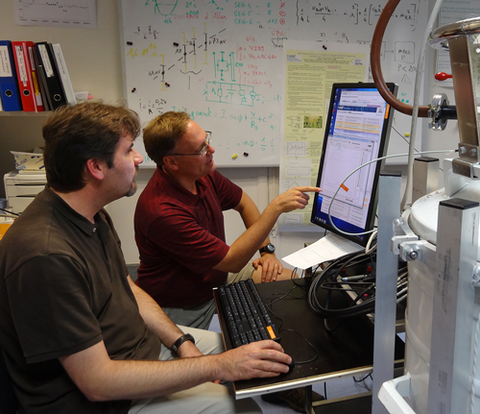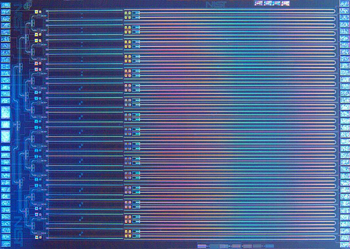
Stephane Solve (left) and Sam Benz test the new quantum voltage standard at BIPM's voltage calibration laboratory.
A PML team has delivered a state-of-the-art 10 V voltage standard to the International Bureau of Weights and Measures (BIPM), where it will serve as the organization's newest primary transfer standard for voltage comparisons with national metrology institutes around the world.
The new Programmable Josephson Voltage Standard (PJVS), employing a novel junction design pioneered at PML, was provided by NIST under a cooperative research and development agreement with BIPM. The system, which was installed and tested at BIPM in late September, will "offer new ease of use as well as new measurement capabilities while maintaining the lowest uncertainties currently achievable," says Sam Benz, who heads the Quantum Voltage Project in PML's Quantum Electronics and Photonics Division.
"This is the first traveling PJVS system designed with compact electronics so that it can be easily transported around the world to any country's national measurement laboratory for comparison with their existing voltage standard. The system will be upgraded in the near future to perform ac voltage calibrations, when the research and development is completed for this feature."
The Quantum Voltage Project scientists and Stephane Solve, a guest researcher from BIPM, spent months in NIST's Boulder, CO labs constructing and testing the new traveling PJVS, and comparing it to a second PJVS system. When measured by sensitive nanovoltmeters, the two systems were found to agree to within 2.6 parts in 1011, with a total combined uncertainty of 3.4 parts in 1011.
"This is the smallest combined uncertainty achieved to date when comparing two PJVS systems," Benz says. "More importantly, it shows that both systems are producing accurate quantum-based voltages as expected for an intrinsic standard."
In the course of that work, the researchers observed – and devised methods to account for – inherent systematic errors in the PJVSs, the largest of which results from electrical connections where the resistance is low enough to allow a tiny current to leak to ground. These leakage resistances can cause measurement errors as large as a few nanovolts. In a recent publication, the team describes measurement procedures to characterize the error and suggests an approach to incorporating it into the total uncertainty budget of the system.
Since 1990, BIPM has represented the SI unit of the volt in terms of the Josephson effect, named after Welsh physicist Brian Josephson who formulated the equations describing the phenomenon 50 years ago. The effect exhibits an invariable, quantized relationship between the voltage and current across a very thin barrier, called a Josephson junction, between two superconductors.

One result is that applying a particular voltage across the junction produces a particular frequency of alternating current (AC). Conversely, when electromagnetic waves are applied to the junction, they produce a perfectly exact corresponding voltage that depends only on frequency, which can be controlled with exquisite precision. This relationship is completely independent of the materials used, configuration of the junction, environmental conditions, or various other influencing variables – a prediction that has survived decades of rigorous scrutiny and has been confirmed as accurate to a resolution of about one part in 1017.
The first Josephson voltage standard (JVS) systems were able to calibrate single dc voltages. The PJVS systems can be rapidly programmed to produce any direct current (DC) voltage between +10V and -10V, which allows them to be used to calibrate sine waves with frequencies up to 500 Hz. The world's first programmable JVS was devised at NIST in the early 1990s.
Since then, several generations of improvements have culminated in the current model, with a 12 mm x 17 mm superconducting integrated circuit that is cooled to 4 K during use. The chip contains 32 parallel microwave channels that distribute the microwave signal to approximately 270,000 junctions made from niobium superconductors separated by niobium-doped silicon – a material combination that ensures fast, stable, quantized voltages.
That design, used in the BIPM system, represents the very latest proven superconducting circuit technology. The BIPM system is the first PJVS optimized for traveling. It includes a lightweight synthesizer that is embedded within the main electronics and advanced filtering that improves performance and protects the chip from inadvertent electrical discharges. During installation in BIPM's voltage calibration lab in Paris, the BIPM system produced quantum accurate voltages with a current range over 1.2 mA, which is 50% larger than the typical 0.8 mA operating margins for most systems and will be a significant advantage when it is taken on the road for comparisons with other national metrology institutes (NMIs).
"The implementation of a NIST PJVS in the laboratories of BIPM fully fulfills a major step in the BIPM missions," says Solve. "BIPM has conducted a program of comparison of Josephson Voltage Standards in DC with NMIs over the last 20 years with more than 50 comparisons. The NIST PJVS will enable BIPM to propose a new key comparison of primary voltage standards in AC voltages in the coming years."

